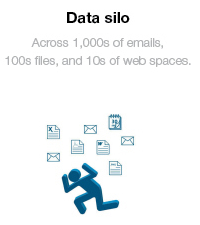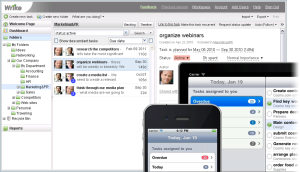This is the first entry in the PM Visionary Series.
I’m quite thrilled to be able to introduce Andrew Filev of Wrike Software. In today’s article, he describes the challenges of globalization, information silos and frustrated scalability that led him on his journey. Please welcome Andrew by leaving your thoughts on his story in the comments section below!
It all started with a personal story. I’ve been managing software development and marketing projects for more than a decade. As any diligent manager, I always strived to increase my own and my team’s productivity, so I continuously explored various project management methods and tools. Traditional apps that I tried mostly came from industrial economy. Our work style was totally different. We had 10+ projects running simultaneously, all constantly evolving. What made things even more challenging is that my projects spanned the globe.
 Our team was far from being alone in this. In fact, these challenges remain the same today for millions of business users. Companies coming to our Web site have similar questions. “We work with a growing number of clients on several projects simultaneously, and at some point in time, traditional methods and desktop tools just weren’t efficient anymore. We couldn’t find a convenient way to get up-to-date information on all the running projects and organize the assignments.” This is how our customer, Lorne Greene, CEO at Viva Communications, describes the challenges his team had before Wrike. I recognize my team during the early 2000’s in this description.
Our team was far from being alone in this. In fact, these challenges remain the same today for millions of business users. Companies coming to our Web site have similar questions. “We work with a growing number of clients on several projects simultaneously, and at some point in time, traditional methods and desktop tools just weren’t efficient anymore. We couldn’t find a convenient way to get up-to-date information on all the running projects and organize the assignments.” This is how our customer, Lorne Greene, CEO at Viva Communications, describes the challenges his team had before Wrike. I recognize my team during the early 2000’s in this description.
Without any productive tools that would work for us, we had to rely on email as the primary communication tool. Long reply-on-reply threads, file attachments buried in the middle of them, overall mailbox chaos that lead to lost assignments – my team was just as familiar with these problems as most other business users. Working with remote teams amplified the importance of collaboration and communication.
 This is how a collaboration platform became one of the key pillars in our product vision. Right now, collaboration tools are on everybody’s wish list, but I was lucky that my personal constraints drove this thinking ahead of the trend, so we could be innovating and leading, instead of copying and following.
This is how a collaboration platform became one of the key pillars in our product vision. Right now, collaboration tools are on everybody’s wish list, but I was lucky that my personal constraints drove this thinking ahead of the trend, so we could be innovating and leading, instead of copying and following.
As the number of information workers, like my team, was rapidly climbing to 1 billion, I started to think it’s a great shame that software “giants” ignored our needs. So I decided we needed a better alternative — an easy-to-use, flexible and scalable tool that would help connect our data across multiple projects, a tool that would blend project management and collaboration, and would become a hub. One hub to rule them all.
Before Wrike, people had their work structured in separate silos that segregate information – thousands of emails that are visible only to the sender and recipients, hundreds of files stored on personal computers and dozens of workspaces in the applications that didn’t give users a way to connect projects to each other. When I was evaluating different tools, I discovered another problem a lot of teams suffered from – adoption difficulties. They were caused by the fact that people were reluctant to manually copy data from emails into their primary project management system or into their intranets. And, obviously, without data, any project management and collaboration system, however advanced its features are, becomes useless. So another big differentiator for us was the early focus on building the market-leading email integration. We later extended this vision to a broader “go where the data is” with mobile versions, APIs and integrations with ubiquitous tools.
 Thus, securing frictionless flow of data into the system was the main purpose of Wrike’s email integration, a unique, patent-pending feature that many of our competitors are trying to imitate. By giving users a way to create, schedule, update and discuss tasks by email, we ensured that data sync doesn’t become a burdensome routine for the users.
Thus, securing frictionless flow of data into the system was the main purpose of Wrike’s email integration, a unique, patent-pending feature that many of our competitors are trying to imitate. By giving users a way to create, schedule, update and discuss tasks by email, we ensured that data sync doesn’t become a burdensome routine for the users.
The email-less office is still a myth, just like the paperless office that quite a lot of people have predicted. We gave our users an easy way to make the info that would otherwise be siloed in their personal inbox appear in the plan that is shared with all involved peers within seconds. We see “corporate crowdsourcing” of data. The users keep communicating the way they’re used to and at the same time keep their project data up-to-date. It’s hard to underestimate this feature when 90% of business users still name email as their primary collaboration tool. It’s also a great way to boost the adoption of the tool and smooth the learning curve for users. Our customers report that Wrike’s email integration helps them get things done 3 times faster!
Developing Wrike, we aimed to ensure that the system is efficient, flexible and easy to use as teams are rolling it out with more people, who evidently pour more and more data into it. As we’ve been moving forward, our product vision has developed into the work graph concept.
The efficiency of the graph model was proven by social networks (with Facebook handling 500M users), and is a great alternative to the segregation model of many collaboration/work management solutions. Wrike was designed from the ground up to scale to hundreds of projects within the organization, while still allowing a specific user to easily get the data he or she needs in just a couple of clicks. Wrike connects all work into a work-graph that is easy to navigate and manage. For example, one of our customers easily manages 7,000 projects with 60,000 tasks in Wrike, all in one workspace. These numbers illustrate how flexible and perfectly scalable Wrike is. Breaking the shells of data silos, Wrike connects 1B information workers in the work graph and provides them with super-efficient vehicles through which the data flows.
 It’s crucially important that as you add more and more projects and tasks into your system, you get more and more value out of it, instead of getting buried in the info. If you are supervising 20 projects, Wrike will help you connect the dots and still give you one point of entry and great visibility.. I believe that such scalability is one of the key things that define the success of any business software. Recently, I gave a speech at Web 2.0 Expo on this topic. If you’re interested in learning more about efficient ways of creating innovative business software, you can check out my slide deck that highlights the main points of my speech.
It’s crucially important that as you add more and more projects and tasks into your system, you get more and more value out of it, instead of getting buried in the info. If you are supervising 20 projects, Wrike will help you connect the dots and still give you one point of entry and great visibility.. I believe that such scalability is one of the key things that define the success of any business software. Recently, I gave a speech at Web 2.0 Expo on this topic. If you’re interested in learning more about efficient ways of creating innovative business software, you can check out my slide deck that highlights the main points of my speech.
One more important thing I want to mention regarding our product vision. What greatly supported us in making Wrike as efficient as it is today is that we always walk the talk. Thoroughly analyzing how our own solution helps us with collaboration challenges, and continuously talking to our thousands customers, we keep sourcing our innovation pipeline. To stay in the loop with our progress, you can subscribe to our blog. We have feature releases every 2-4 weeks.
Our efforts are focused on moving online project management to a new level, where all the team members, not just managers, can benefit from project collaboration in a centralized place, just as easy as using everybody’s favorite social networks. Giving business users an easy and efficient way to collaborate on projects in real time through the Web, email and smartphones, Wrike has won over thousands of customers across the globe, from small nonprofits to international business leaders, such as Ecco, Salesforce, eBay and CBS Interactive.
 Andrew Filev, founder and CEO of Wrike, an experienced project manager and a successful software entrepreneur, focuses on improving project management tools and methods with the help of new-generation technologies. His best practices are based on the implementation of Enterprise 2.0 software in project management. Andrew’s views on changes in contemporary project management are reflected in his Project Management 2.0 blog. Andrew has written more than 30 online and offline articles on new trends in project management and deployment of the next-generation, Web-based applications, and he has given speeches at the UTD PMI Symposium, Office 2.0 Conference, Web 2.0 Expo, Enterprise 2.0 Conference and over a dozen other events.
Andrew Filev, founder and CEO of Wrike, an experienced project manager and a successful software entrepreneur, focuses on improving project management tools and methods with the help of new-generation technologies. His best practices are based on the implementation of Enterprise 2.0 software in project management. Andrew’s views on changes in contemporary project management are reflected in his Project Management 2.0 blog. Andrew has written more than 30 online and offline articles on new trends in project management and deployment of the next-generation, Web-based applications, and he has given speeches at the UTD PMI Symposium, Office 2.0 Conference, Web 2.0 Expo, Enterprise 2.0 Conference and over a dozen other events.
